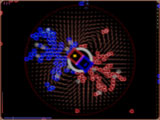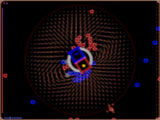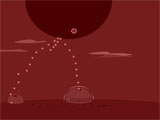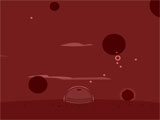Opposites Do Attract: + | –
I have always been astonished by magnetism. To me, there’s nothing like that awed amusement you get when two blocks of metal eerily push each other apart, and sprinkling iron filings near magnets just to see the field lines never loses its charm. So you can imagine how intrigued I was by an arcade-style action puzzle game centered around the theme of magnets.
Attractive Concept
Enter +|- (pronounced plus or minus), in which the player controls a standard bar magnet that can rotate or reverse polarity. The premise is fairly simple: eliminate oppositely-charged particles by causing them to touch. The particles appear randomly and swarm around the magnetic field, gradually drawing closer until they stick to the circle which encloses your magnet avatar. The particles build up into heaps, and if they grow too tall, it’s game over.
Playing in hard mode introduces a new element that drastically affects the game. When you fail to score points in a certain amount of time, a neutral particle is spawned as a sort of punishment. Neutral particles cannot be interacted with, so once they’re stopped, they’re there permanently, unless you make use of the screen-clearing special attack.
Repulsive Implementation
The problem with +|- is that there is little sense of control and little room for strategy. It’s not frustrating per se, just overwhelming. At first, I thought the pace of the game was too slow — almost boring. Very suddenly, I found myself at the mercy of an onslaught of particles: building up piles on opposite sides, switching the polarity, and hoping for the best. The action in +|- is all-or-nothing, and simply seems too luck-based.
The vector field your magnet generates is visible, but it really doesn’t help: we just don’t have the instinct built up to easily understand magnetism. Vector fields are not something most people deal with in the everyday world, and as a consequence, the physical nature of +|- does not lend itself to intuition as readily as other games. This alone isn’t a bad thing; in fact, I usually think it’s fascinating when a game requires me to adapt to a strange new world. In this world, though, the element of control feels weak: it sometimes seems like I might as well be spinning the magnet around randomly for all the good it’s doing. (Of course, I concede the possibility that I’m just really bad at the game.)
Neutral Rating
+|- isn’t unplayable, but it could certainly use a little polish — a wishy-washy term, I know, but it’s difficult to pin down what +|- lacks. Perhaps something as simple as slowing the motion of the particles could allow for more thinking and less reflexive gameplay, or perhaps a series of levels could be added featuring multiple magnets in different configurations. It feels like +|- could be so much more than it is. For the time it took rale and co. to develop, +|- is something to be proud of, but you probably won’t see it becoming a smash hit anytime soon.
Download +|- (4.05 MB)
[via the Experimental Gameplay Project]
Related Posts:
De Blob Coming to Wii
I’m way late in pointing this out–in fact, there’s a lot of “De Blob” search traffic coming in–but it’s worth mentioning again. De Blob, formerly a student project at Utrecht, is making its way onto the Wii via publishing deal with THQ. Congrats guys!
Read my De Blob review (the one-level PC version).
The above clip is from IGN’s preview of the Wii version. Looks fantastic!
Defend Your Monochromatic Turret in Red
Red is a wonderfully simple game using realistic physics to take the Missile Command concept to a new level with a greater suspension of disbelief and emotional intensity. You can find Red floating around any number of flash gaming sites, but it is oddly missing from Armor Games (the game’s credited source).
Simple Concept Goes a Long Way
I really appreciate the simplicity of Red because its physics inherently produce room for strategic thought. The player uses the mouse to blast small balls from a round turret at much larger balls hurtling downward from the sky. Each interaction between your “bullets” and the slowly approaching “meteors” applies realistic physics, bouncing the bullets out in different directions and pushing the oncoming meteors up and away. Just selecting the part of a meteor to shoot is a challenge when you only have a fraction of a second. Also, the chaotic spray of bouncing bullets can be used to your advantage when they bounce off of one target and into another. This suggests an interesting multi-tasking element when you must blast 2 or 3 meteors at the same time, but the concept is mostly unexplored.
Massive Impact
After 30 seconds or so, power-ups will show up, allowing you to obtain a force field, supporting turrets or (my personal favorite) extra heavy bullets that pound the sky clean and ricochet into the ground, leaving dark, gaping holes. Those slugs really demonstrate the effect physics can have on a game experience. Each physical interaction lets you know you’re not just hurling a bunch of pixels, you’re packing mass! This is what separates Red from a non-physics game like Missile command.
Unexercised Variety
Occasionally, a particularly gargantuan ball will arise, marking the end of a phase and the beginning of a greater difficulty level. Just as one would expect, higher levels mean more and faster balls to shoot, but they’re also the harbingers of new wind-speeds. Changing wind effects keep things dicey, forcing you to compensate for the curvature of your bullets’ trajectories. Unfortunately, that’s when the game’s variety peters out, which is disappointing because a great deal of even simple possibilities were ignored (like meteors with less predictable trajectories, a moving turret or zooming out to shoot at longer ranges). After a few minutes of play you’ve seen all that’s worth seeing and you’re probably just hoping you’ll die an honorable death at the hands of a meteor instead of exiting the game like a coward. That’s a place I never like to be.
10% of a Great Game
Overall I found Red to be a really fantastic basis for a game, but it feels more like a demo than a full experience. Click the “About” button and the mysterious creator, ” Case,” suggests Red is the beginning of a series of chromatically named games. Orange was the only one I could find available and I wasn’t impressed.
Red is free so give it a go, but don’t expect to be entertained for longer than a few minutes. Let’s hope our friend Case has some new concepts up his sleeve for the next project. He demonstrates an excellent use of the mouse interface and basic physics to produce an intuitive and entertaining game.
Play Red Online (Flash required)
Related Posts:
- No related posts








 My name is Matthew Wegner, and this site is dedicated to physics games.
My name is Matthew Wegner, and this site is dedicated to physics games.